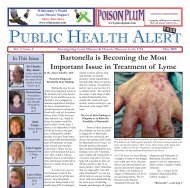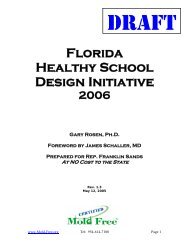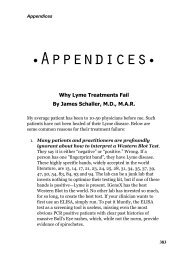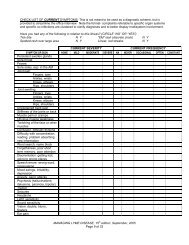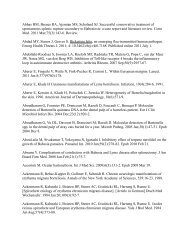Download Here - James L. Schaller, M.D., M.A.R., P.C
Download Here - James L. Schaller, M.D., M.A.R., P.C
Download Here - James L. Schaller, M.D., M.A.R., P.C
You also want an ePaper? Increase the reach of your titles
YUMPU automatically turns print PDFs into web optimized ePapers that Google loves.
Environmentally Friendly Mold Remediation Techniques That Significantly Reduce Childhood Asthmaprecaution, fans that create airflow by blowing should no longer beused once visible mold appears, and drying should then proceedunder more controlled conditions to avoid dispersing mold particles.Moisture source(s) that have led to mold growth must be identifiedand understood in order to plan an effective mold remediationproject. Finding the locations of excess moisture, identifying themechanisms for its accumulation or infiltration, and tracing pathwaysof its migration can also aid in finding and assessing the likelihood ofencountering further growth.Oftentimes the source of moisture cannot be accurately pinpointeduntil the water damaged drywall is removed. For example, once thedrywall is removed, small openings in window or door caulking can beeasily found close to the heaviest mold concentrations on wood or drywall.Those responsible for correcting and preventing mold problemsshould recognize that moisture in any of its phases (ice, water, andvapor) must be adequately controlled. For example, moisture may bepresent at a material’s surface as high relative air humidity. Moisturecan also be absorbed into porous and semi-porous materials and maymigrate under surface coverings, around furniture, and betweencomponents at joints. Understanding the moisture sources and dynamicsinvolved in a particular situation may require professional assistance.During the mold remediation project itself, it is necessary to controlthe use or production of water. For example, cleaning techniquesshould use water-based solutions sparingly and must include rapiddrying following the cleaning steps, or the water-based cleaner shouldinclude some mold inhibitor/disinfectant. Power washing should notbe performed if vulnerable material, such as wallboard and sheet rock,might get wet. Power washing of wood trusses or furring – inbuildings before drywall or AC ducts are in – can be quite effectivewhen disinfectant/mold inhibitor is added to the auxiliary powercleaner mixing chamber.1 See Appendix B resources for detailed decontamination protocols.82





